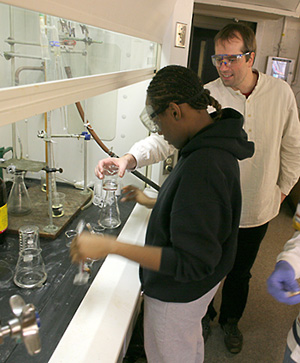Princeton University
Princeton Weekly Bulletin April 9, 2007, Vol. 96, No. 22 prev next current
- Page One
- • Wrestling with great books and ideas
- • University offers admission to 9.5 percent of applicants
- Inside
- • New chemistry approach promises less expensive drugs
- • Construction starts on new building between engineering, social sciences
- • Davis gift establishes endowment for International Center
- • Study of coastal disasters yields surprising findings, arresting images
- • Historic map exhibition, lecture set on exploring Africa, April 15
- Freshman Seminars overview
- • Thinking critically about computing, biology and society
- • Freshmen get a taste of chemistry — through chocolate
- • ‘Troubling’ students’ beliefs about black music
- People
- • Spotlight
- Almanac
- • Calendar of events
- • Nassau notes
- • By the numbers
- The Bulletin is published weekly during the academic year, except during University breaks and exam weeks, by the Office of Communications. Second class postage paid at Princeton. Postmaster: Send address changes to Princeton Weekly Bulletin, Office of Communications, Princeton University, 22 Chambers St., Suite 201, Princeton, NJ 08542. Permission is given to adapt, reprint or excerpt material from the Bulletin for use in other media.
- Subscriptions. The Bulletin is distributed free to faculty, staff and students. Others may subscribe to the Bulletin for $30 for the 2006-07 academic year (half price for current Princeton parents and people over 65). Send a check to Office of Communications, Princeton University, 22 Chambers St., Suite 201, Princeton, NJ 08542.
- Deadlines. In general, the copy deadline for each issue is the Friday 10 days in advance of the Monday cover date. The deadline for the Bulletin that covers April 23-29 is Friday, April 13. A complete publication schedule is available at www.princeton.edu/ pr/ pwb/ deadlines.html; or by calling (609) 258-3601.
- Editor: Ruth Stevens Calendar editor: Shani Hilton Staff writers: Jennifer Greenstein Altmann, Eric Quiñones Contributing writers: Emily Aronson, Chad Boutin, Cass Cliatt, Teresa Riordan, Steven Schultz Photographers: Denise Applewhite, John Jameson Design: Maggie Westergaard Web edition: Mahlon Lovett
Freshman Seminars
Freshmen get a taste of chemistry — through chocolate
By Chad Boutin
Princeton NJ — Stefan Bernhard passes around another small dish covered with shards of a familiar dusky substance and directs his 12 freshmen to make a scientific observation about them.
“Let a piece dissolve in your mouth, and compare how the residue feels and tastes,” he says — a bit indistinctly, for he is already making his own observations along with the group. A baker’s dozen mouths swirl first with melting confection, then with words to describe it.

Stefan Bernhard (right), assistant professor of chemistry, assists freshman Miriam Camara as she works with chocolate under a fume hood. (photo: John Jameson)
“It’s not as grainy as the first one,” someone volunteers. “Denser too, and it breaks more crisply,” another says. “Ah, that’s the ‘snap,’ that’s what we want,” says Bernhard, who then launches into a tasty disquisition on a few details of chocolate-making, a process he learned intimately while growing up in Switzerland, years before joining Princeton’s chemistry department.
“I worked in a chocolate factory for three years as a teenager, and discovered there is a lot of chemistry involved in producing high-quality chocolate,” said Bernhard, now an assistant professor. “When my colleague Rob L’Esperance heard about my background, he said, ‘You have to teach a course on this.’”
Bernhard is now teaching a Richard L. Smith ’70 Freshman Seminar on “The Chemistry of Chocolate” for the second time, leading first-year students through many of the same scientific tests he performed when he was about their age. Each Wednesday, after spending a few minutes in the lab placing flasks of solid chocolate into a heater for melting, the group gathers in a classroom to attune their taste buds to one aspect of chocolate’s character — how evenly its fats have crystallized, for example, or how large the solid particles it contains are — before returning to the lab to explore the chemistry behind this aspect of their favorite food.
“I’m basically a chocoholic,” said freshman Julie Dickerson. “But since I know I want to go into the humanities, this is a good way to learn some science.”
On this particular day, she and her classmates dissolved the fats in the melted chocolate with liquid hexane, then poured the solution through a sieve to determine the size of its particles of cacao — the South American bean from which chocolate is made. The smaller the particles, Bernhard explained, the less gritty the chocolate feels on the tongue.
“I’m trying to provide an attraction to science for students who might not otherwise be interested,” he said. Indeed, nearly all of the students are leaning toward nonscientific majors, but the attraction is definitely working: The course has had several times as many applicants as he has had seats available.
Bernhard said he tries to provide just the right mix of hard science and fun, which naturally includes the finer points of chocolate tasting. Though he enforces a no-snacking rule in the lab and only provides about half a bar per week for tasting, he knows he needs to issue a disclaimer.
“I tell them right at the beginning I’m not responsible for any pounds they gain from taking the class,” he said.
See additional articles about Freshman Seminars in this issue.

